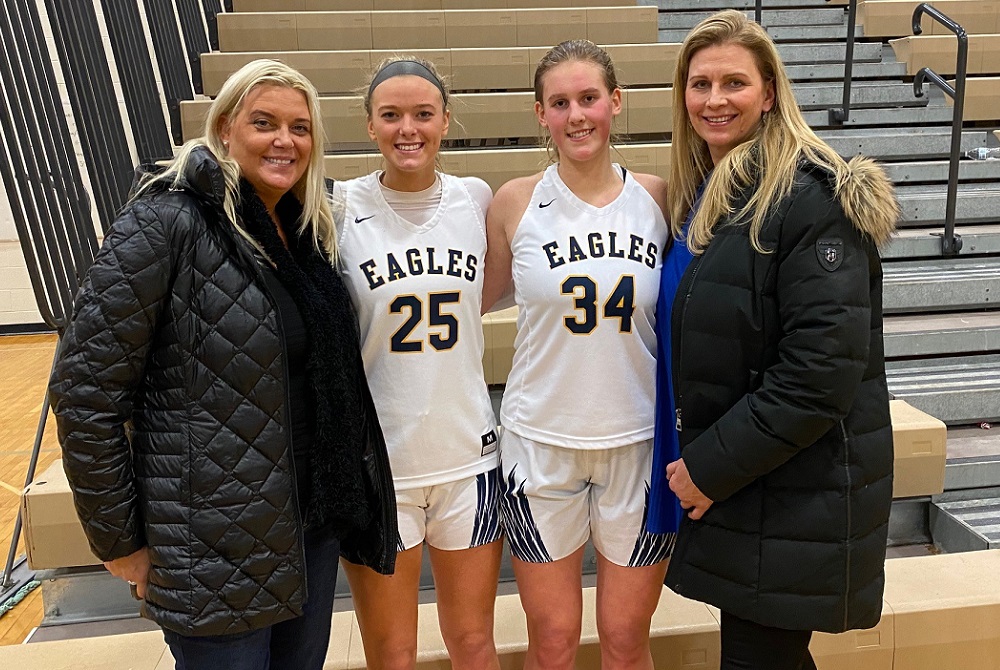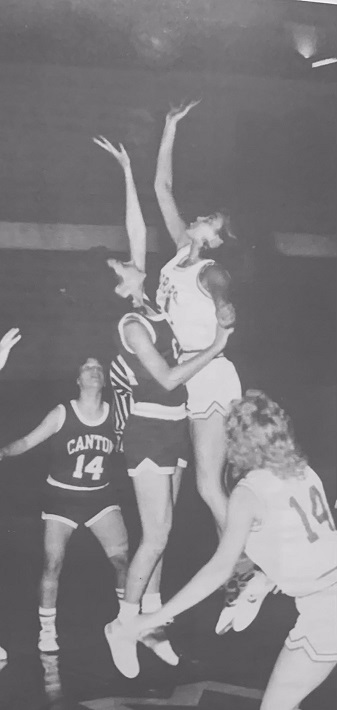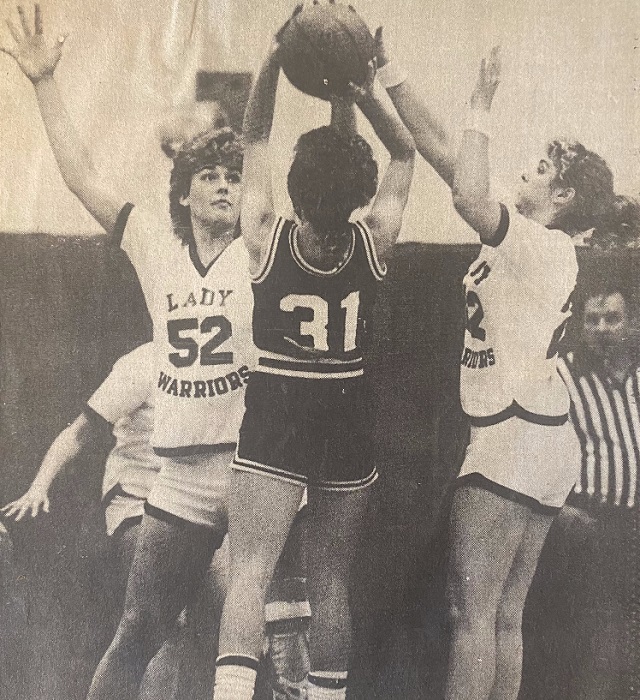
Hall Sisters' Daughters Giving Hartland Next-Generation Boost
By
Tim Robinson
Special for MHSAA.com
February 11, 2022
HARTLAND — Hartland girls basketball coach Don Palmer chuckles now when he talks about facing the Hall sisters 30 years ago, when they were at Walled Lake Western and he was at Milford.
 “I never could beat them,” he said, recalling facing Valerie, Dianne and Michelle Hall, all of them 6 feet tall or taller. “That in itself was a rarity, and they were so athletic. We played against the Halls when I had some of my best teams (at Milford). We never beat them, and they never cease to remind me of it.”
“I never could beat them,” he said, recalling facing Valerie, Dianne and Michelle Hall, all of them 6 feet tall or taller. “That in itself was a rarity, and they were so athletic. We played against the Halls when I had some of my best teams (at Milford). We never beat them, and they never cease to remind me of it.”
A little less than 20 years later, Val and Dianne and their families moved to Hartland about the time Palmer was taking over the Eagles program.
“Whitney was in the third or fourth grade,” Dianne Sollom recalled. “He was like, ‘Oh, the Hall girls! I could never beat you guys!’ And I said, ‘I have Whitney and another one coming in. They’ll be playing for you one day.’”
Whitney Sollom played four years for Palmer and is now a sophomore on the University of Michigan basketball team, a second-generation part of the program as Dianne also played for the Wolverines.
Whitney’s younger sister, Lauren, is a senior starter for the Eagles. One of her teammates is her cousin Sarah Rekowski, Val’s daughter.
“I played with my sister and now I’m playing with Sarah,” Lauren Sollom says. “I know my family is out there with me on the court going through the same thing I am. It’s very special to me.”
Lauren, who has signed to play at Saginaw Valley State, is a senior starter, while Sarah is a sophomore.
They are both from a college sports background. Lauren’s father, Ken, was a quarterback at Michigan and Sarah’s father, Stephen, was a defensive tackle for the Wolverines during the 1990s.
Dianne, who graduated from Western in 1989 and played basketball for Michigan State, met her husband when visiting Val at U-M.
“They grew up in it,” Dianne Sollom said. “If I’m not telling them, (Val) is telling them.”
Like their mothers, Lauren and Sarah are tall. Lauren is a 6-3 forward, while Sarah is a 6-2 post player for the Eagles.
Dianne says she’s 6 feet tall, “but I’m as tall as you want me to be,” she jokes. Val, a 1985 Western grad, was 6-4 in her playing days, as was their younger sister, Michelle.
Val played all four years at Michigan, and Dianne three years at Michigan State.
 “With my mom being a post player and my being a post, it helps me to know what to do in certain situations, and she gives me pointers,” Sarah said. "She’s always helping me with my game.”
“With my mom being a post player and my being a post, it helps me to know what to do in certain situations, and she gives me pointers,” Sarah said. "She’s always helping me with my game.”
But both moms have their limits.
“We do watch film together,” Val says of her time with Sarah, “but not a lot. I let Coach Palmer handle all that. I know Dianne and Ken have that ongoing conversation and try to help when they can. But you have to back off. A lot of the time they don’t want to hear you at all. You have to give them some time, that 24 hours or whatever.”
Sarah enjoys the physical portion of the game and showed her potential in the season opener, when she had 13 points and eight rebounds. Lauren will get inside for rebounds, but plays mostly on the perimeter, hoisting up 3-pointers, something Sarah hasn’t done yet.
“Coach Palmer has not given her the pass yet,” Lauren pronounced as both giggled.
“Coach Palmer would probably lose his mind,” Sarah said, grinning.
“He definitely would,’ Lauren said, to more laughter.
Sarah played on the JV team as a freshman last season, although her winter was interrupted by 10-day COVID-19 quarantines on a couple of occasions.
“She’s a little behind in her development,” Palmer said of Sarah, “but she really is a talented kid. She’s a big kid who, when she gets a rebound, it really is a rebound. We’re working on her constantly on her footwork.”
Sarah has been alternating with 6-4 senior Kate Jacobs in the post.
“It’s been up and down,” she says, “but I’ve gotten a lot of experience. I’m getting a decent amount of playing time.”
Lauren, meanwhile, is a team captain.
“Lauren’s a team-first player,” Palmer said. “She’s having a great year for us, she’s our leading scorer, leading rebounder and she’s having an MVP kind of year.
“They’re good kids,” Palmer said of the cousins. “They want to win, and they don’t care about how they do it. That’s the thing about this team. They’re all unselfish kids; you know, if they get 15 one night and get two the next and the team won both, they’re fine.”
In addition, Lauren’s fraternal twin brother, Brad, plays for the Hartland boys basketball team and will suit up at Concordia University in Ann Arbor next year, where he will play football.
For now, Lauren and Sarah are enjoying their year of varsity basketball together.
“We talk a lot,” Lauren said. “Basketball brings us together. Practices are fun, and I drive her to school in the morning and home in the evening. That’s good cousin time, family time.”
Speaking of family time, when Dianne (for MSU) and Michelle (U-M) played against each other in college, it was not unheard of for one sister to let the other have the occasional free lane to the basket, or for one to congratulate the other on a good shot while both were on the floor.
Once, castigated for complimenting her sister, Dianne said to her coach, “But she’s my sister!”
 Now, Dianne and Val sit in the stands at Hartland games, cheering their daughters on.
Now, Dianne and Val sit in the stands at Hartland games, cheering their daughters on.
“I enjoy watching her play,” Val said. “We’ve been watching Whitney and Lauren since they were young, and Sarah’s coming along. It’s fun to watch the light bulb come on and everything starts clicking. It’s really great when it all comes together for them.”
“I was on the court my entire life,” Dianne said. “I want to sit in the stands and watch my daughter and son. My husband is in the same boat. We’ve done it. We don’t have to shine.”
Hartland has been one of the top teams in the state this season, and the Eagles are looking toward a long run in the MHSAA Tournament, not unlike last year, when they reached the Division 1 quarterfinals.
To do so, the Eagles (14-1) are combining talent with togetherness, with nine seniors, including Lauren Sollom, looking out for themselves and a big sophomore in Sarah Rekowski who could play a key role down the stretch.
“She’s a very hard worker in practice and always has a smile on her face, even when Palmer is yelling at her,” said Lauren, joining her cousin with more giggles in a postgame interview, another shared moment in a season that already has produced memories for a lifetime and a special bond within a bond.
PHOTOS (Top) Dianne Sollom, far left, and Val Rekowski, far right, stand with daughters Lauren Sollom (25) and Sarah Rekowski (34) after a Hartland game. (Middle) Dianne Sollom, second-from-right, takes the opening jump against Canton while playing for Walled Lake Western. (Below) Val Hall (52) gets her hand on a shot while also starring for Walled Lake Western in this Novi-Walled Lake News clipping. (Top photo by Tim Robinson, middle and bottom photos provided by the Sollom and Rekowski families.)

- Boys Swim & Dive
- Wrestling
- Girls Swim & Dive
- Competitive Cheer
- Girls Bowling
- Girls Skiing
- Boys Skiing
- Girls Basketball
- Boys Basketball
- Boys Bowling
- Gymnastics
- Ice Hockey
- MHSAA News
MHSAA Winter Sports Start with Extended Basketball Schedules, New Wrestling Weights
By
Geoff Kimmerly
MHSAA.com senior editor
December 13, 2022
The addition of two games to basketball regular-season schedules and a new series of wrestling weight classes are likely the most noticeable Winter 2022-23 changes as an estimated 65,000 athletes statewide take part in 13 sports for which the Michigan High School Athletic Association sponsors postseason tournaments.
Girls gymnastics and boys ice hockey teams were able to begin practice Oct. 31, with the rest of those sports beginning in November – including also girls and boys basketball, girls and boys bowling, girls competitive cheer, girls and boys skiing, Upper Peninsula girls and boys and Lower Peninsula boys swimming & diving, and girls and boys wrestling.
A variety of changes are in effect for winter sports this season, including a several that will be noteworthy and noticeable to teams and spectators alike.
Basketball remains the most-participated winter sport for MHSAA member schools with 33,000 athletes taking part last season, and for the first time, basketball teams may play up to 22 regular-season games. This increase from the previous 20-game schedule allows more games for teams at every high school level – varsity, junior varsity and freshman.
Another significant change has been made in wrestling, as the majority of boys wrestling weight classes have been adjusted for this season in anticipation of a national change coming in 2023-24. The updated boys weight classes are 106, 113, 120, 126, 132, 138, 144, 150, 157, 165, 175, 190, 215 and 285 pounds. Only 215 and 285 remain from the previous lineup. There is also one change to girls weight classes, with the 255 class replaced by 235 to also align with national high school standards.
A series of notable changes will affect how competition takes place at the MHSAA Tournament levels. In hockey, in addition to a new classification process that spread cooperative and single-school programs evenly throughout the three playoff divisions, the MHSAA Tournament will employ two changes. The Michigan Power Ratings (MPR) will be used to seed the entire Regional round, not just the top two teams, and prior to the start of Semifinals, a seeding committee will reseed the remaining four teams in each division with the top seed in each then facing the No. 4 seed, and the No. 2 seed facing No. 3.
Bowling also will see an MHSAA Tournament change, as the Team Regional format will mirror the long-standing Team Final with teams playing eight Baker games and two regular games at both levels. And as also applied during the fall girls season, there is a new qualification process for divers seeking to advance to Lower Peninsula Boys Swimming & Diving Finals. In each of the three divisions, each Regional will be guaranteed 10 qualifiers for the Finals, with six more “floating” qualifier entries to be distributed to the Regionals that have one of the previous year’s top six returning Finals divers in their fields. If a team changes division from the previous season, any floating top-six spots are added to the six already allowed in the school’s new division.
A gymnastics rules change provides an opportunity for additional scoring during the floor exercise. A dance passage requirement was added in place of the former dance series requirement to encourage creativity and a more artistic use of dance. The dance passage requires gymnasts to include two Group 1 elements – one a leap with legs in cross or side split position, the other a superior element.
In competitive cheer, the penalty for going over the time limit in each round was adjusted to one penalty point for every second over the time limit, not to exceed 15 points. The new time limit rule is more lenient than the past penalty, which subtracted points based on ranges of time over the limit.
The 2022-23 Winter campaign culminates with postseason tournaments, as the championship schedule begins with the Upper Peninsula Girls & Boys Swimming & Diving Finals on Feb. 18 and wraps up with the Boys Basketball Finals on March 25. Here is a complete list of winter tournament dates:
Boys Basketball
Districts – March 6, 8, 10
Regionals – March 13, 15
Quarterfinals – March 21
Semifinals – March 23-24
Finals – March 25
Girls Basketball
Districts – Feb. 27, March 1, 3
Regionals – March 7, 9
Quarterfinals – March 14
Semifinals – March 16-17
Finals – March 18
Bowling
Regionals – Feb. 24-25
Finals – March 3-4
Competitive Cheer
District – Feb. 17-18
Regionals – Feb. 25
Finals – March 2-3
Gymnastics
Regionals – March 4
Finals – March 10-11
Ice Hockey
Regionals – Feb. 20-March 1
Quarterfinals – March 4
Semifinals – March 9-10
Finals – March 11
Skiing
Regionals – Feb. 13-17
Finals – Feb. 27
Swimming & Diving
Upper Peninsula Girls/Boys Finals – Feb. 18
Lower Peninsula Boys Diving Regionals – March 2
Lower Peninsula Boys Finals – March 10-11
Wrestling – Team
Districts – Feb. 8-9
Regionals – Feb. 15
Finals – Feb. 24-25
Wrestling – Individual
Districts – Feb. 11
Regionals – Feb. 18
Finals – March 3-4
The MHSAA is a private, not-for-profit corporation of voluntary membership by more than 1,500 public and private senior high schools and junior high/middle schools which exists to develop common rules for athletic eligibility and competition. No government funds or tax dollars support the MHSAA, which was the first such association nationally to not accept membership dues or tournament entry fees from schools. Member schools which enforce these rules are permitted to participate in MHSAA tournaments, which attract more than 1.3 million spectators each year.

